MXA INTERVIEW JOHN DESOTO: THE FLYIN’ HAWAIIAN PAYS IT BACK
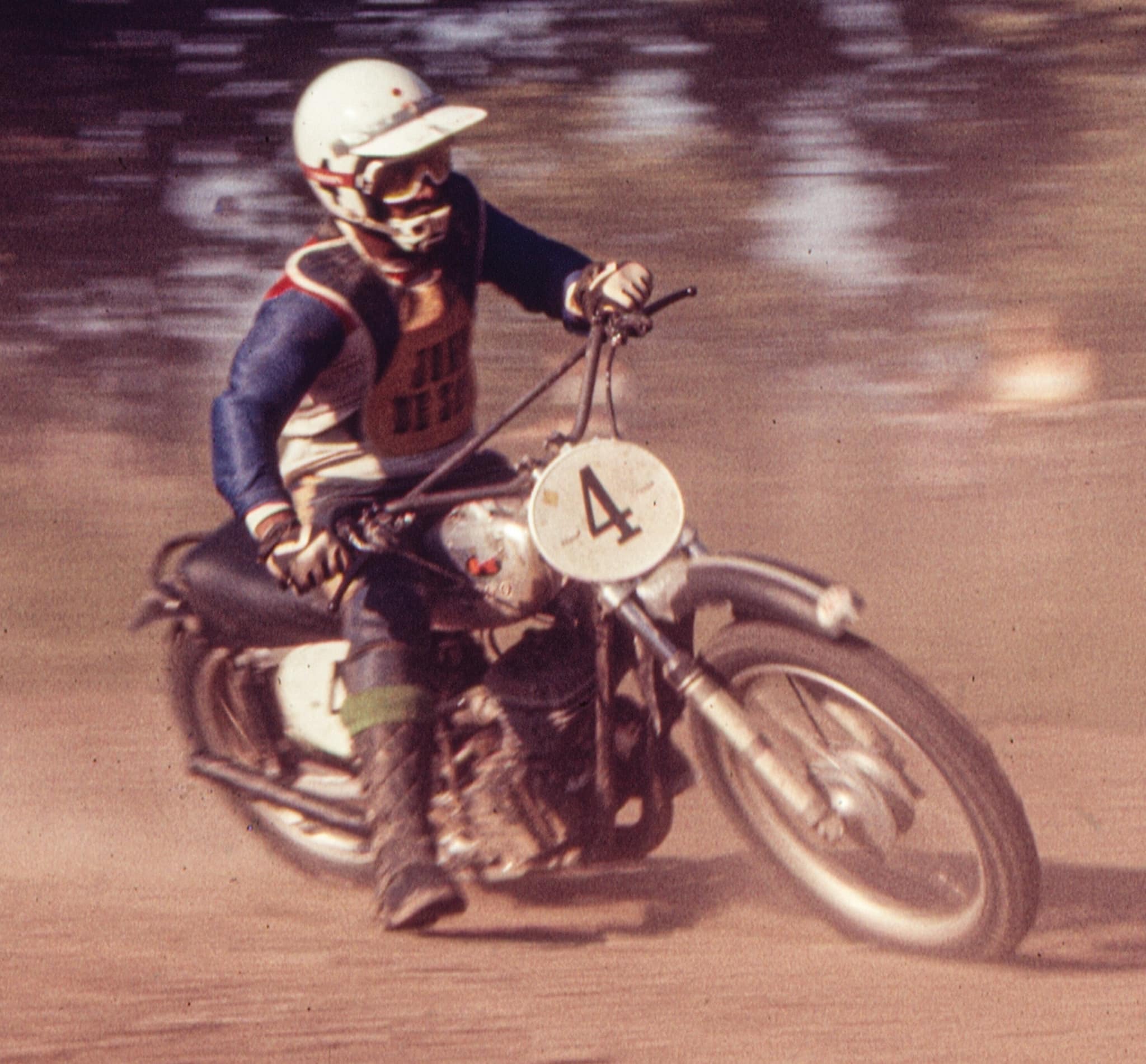 John DeSoto on his works Kawasaki in 1973.
John DeSoto on his works Kawasaki in 1973.
BY JIM KIMBALL
JOHN, WHAT WAS YOUR INTRODUCTION TO MOTORCYCLES? I was 5 years old, and my dad put me on his motorcycle. That was my introduction. It was a Harley-Davidson with a suicide clutch. The clutch was not on the handlebar; it was down by your foot; however, the shifter was up by your left arm. He put me on the front of the bike, and as we started moving, he stepped off the back. It was just me, and I thought, “what the heck is going on” I could not even touch the ground. My feet would not reach the foot pegs. Finally, I had to stop the bike, so I saw a 55-gallon drum down by the beach and I went towards it. I hit it and fell over. I got up and looked at my mom. My mom had her purse and was beating my dad with it.
“I WAS 5 YEARS OLD, AND MY DAD PUT ME ON HIS MOTORCYCLE. THAT WAS MY INTRODUCTION. IT WAS A HARLEY-DAVIDSON WITH A SUICIDE CLUTCH. ”
BUT YOU LIKED IT RIGHT AWAY? In Hawaii, we had scrambles, TT and Hare and Hound events, and my dad did those. When I was old enough to ride, I got a Francis Barnett motorcycle; they called them Fanny Bs. Later, I got a Triumph Tiger Cub and raced. In Cycle News, I saw photos of Eddie Mulder and thought, “That is what I want to do.” Eventually, after high school, I went to college in Utah. I had a football scholarship to go there.
HOW DID YOU END UP IN CALIFORNIA? It was Christmas vacation time in college, and I had two weeks off, so I went to California. It was unreal. I saw a lot of racing there. People were lending me motorcycles. I never went back to college. I said, “This is it!” I did not tell my parents right away.
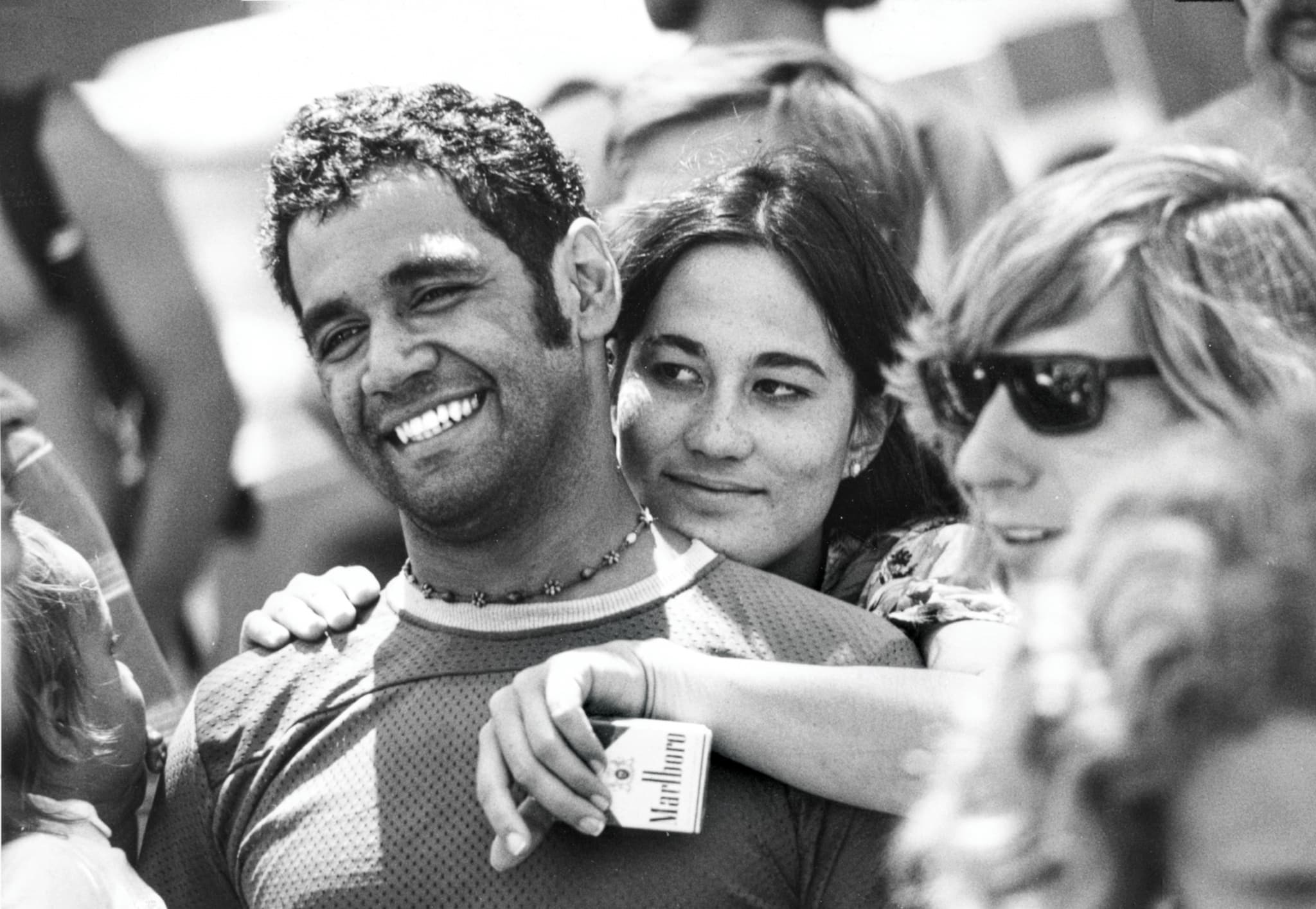 John and Pati at an AMA National riders’ meeting.
John and Pati at an AMA National riders’ meeting.
WHAT CAME NEXT? Kim Kimball, Tommy Smothers and Dan Gurney were the Montesa importers. They saw me race and said, “Let us get you a bike, and you can race it.” I did not have a vehicle. I used to borrow a Volkswagen to pick up a Montesa from Kim Kimball’s shop. I would take the front and backseat seat out of the Volkswagen and take off the handlebars and front wheel and load it up. Then I would drive all the way down to Carlsbad or wherever to race. During that time, I was homeless for about six months. I slept in an abandoned car in a parking lot in North Hollywood.
JUST A RANDOM PARKING LOT? No, it was the parking lot next to the Montesa building. One day Kim Kimball saw me coming out of that abandoned car and asked, “What the heck are you doing?”
I said, “I don’t have my key for my apartment, so I stayed here overnight.” I was lying.
He said, “I will take you to your apartment.”
I said, “No. No, I can walk.” I did not have a car.
He said, “No. I am going to drop you off at your apartment.”
Kim put me in a car, and I thought, “Oh boy, this is going to be weird.” I saw some apartments and I said, “Right here.” They said, “Okay.” When I got out, I said, “Thank you.”
I went far into the apartment building, and eventually thought they had left, so I walked back out and suddenly I saw the factory Montesa van backing up. Kim looked at me and asked, “Do you live there?” I said, “Yes, I just decided to get something to eat.” Kim said, “John, I know you are lying. We have seen you in that abandoned car next to the shop. Come on, we are going to take you back to the shop right now.” I thought I was going to lose my ride for sure.
Kim Kimball got on the phone with Dan Gurney. After talking for a few minutes, he said, “We are going to give you a salary and a van so you can get around.” I looked at him and said, “What?” It was completely amazing and awesome; I was so stoked. They paid for an apartment. I just felt like I was in heaven. Here I thought I would lose everything, but I got everything. I will never forget that.
HOW FREQUENTLY DID YOU RACE? I would race Wednesday, Thursday and Friday nights, and I’d go to Saddleback on Saturday and Carlsbad on Sunday. For the big races, I would fly out, race and fly back. I would make some money from all the races, plus I was getting paid a salary from Montesa. This allowed me to pay for my apartment. It was not that much money, but I just wanted to ride. Whether I came in first, second, third or even last, I felt like I still won because I did something that not too many people had the privilege of doing, especially with me being from Hawaii.
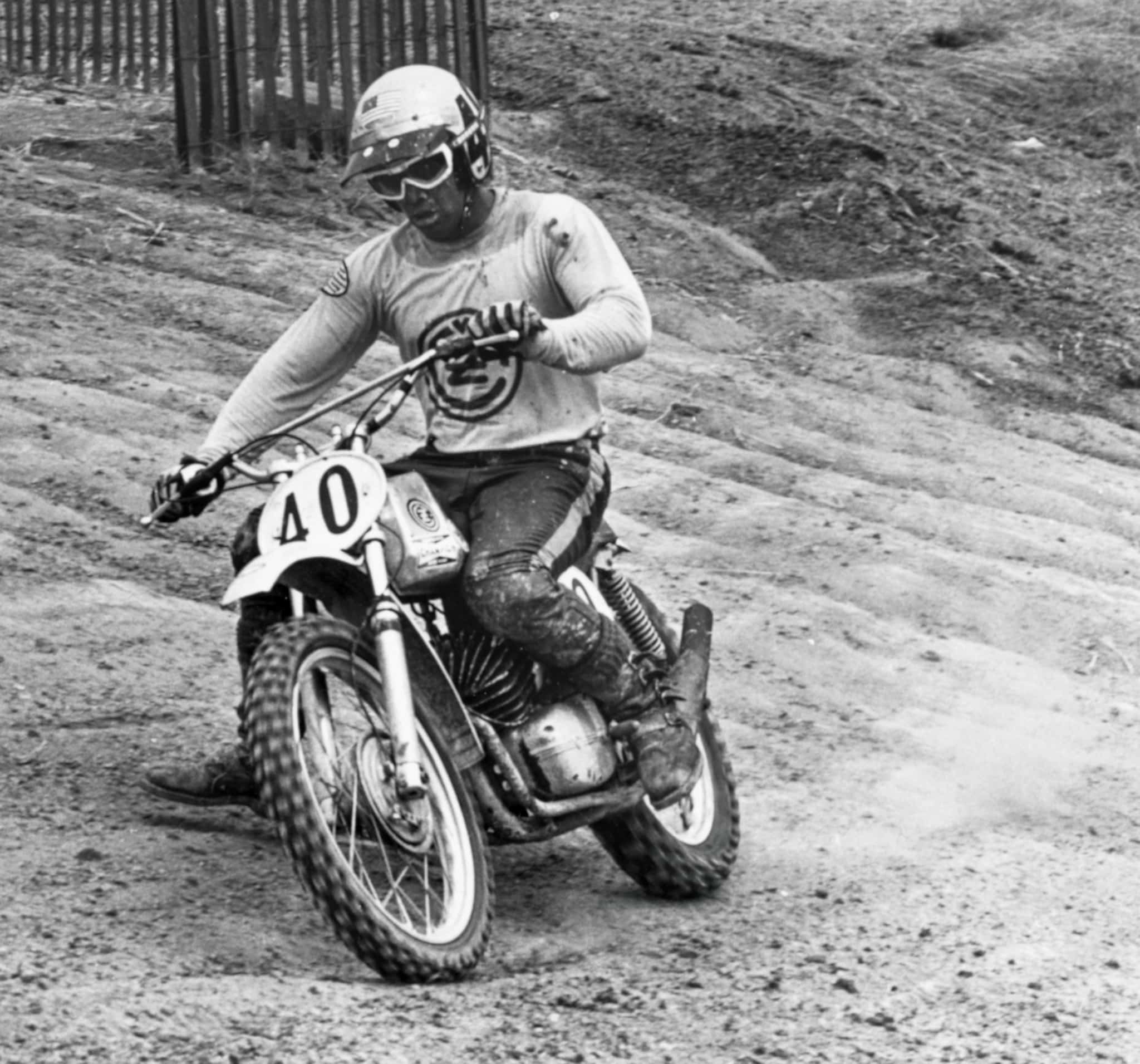 John said that the first time he sat on a CZ he felt, “The CZ was built for me.”
John said that the first time he sat on a CZ he felt, “The CZ was built for me.”
HOW LONG WERE YOU WITH MONTESA? MOST PEOPLE REMEMBER YOU ON A CZ. Ronnie Nelson and I were sponsored by Montesa, so we used to do a lot of races together. We went to Yugoslavia to represent America in the Motocross Des Nations. That was where I first saw a CZ. Joel Roberts and Roger Decoster were the CZ team. I looked at it, then sat on it and thought, “Wow, this fits me. I love this bike!” That is when CZ asked me to ride for them.
“SUZUKI WAS REALLY A POWERHOUSE BACK THEN. TECHNICALLY, IT WAS NOT THAT DIFFERENT FROM THE KAWASAKI. THE BIG DIFFERENCE WAS IN HOW MUCH MORE MONEY THEY PAID ME. ”
WHAT WERE JOEL AND ROGER LIKE? My first real experience with Joel was later at Hangtown when we were racing together. I got the holeshot, and he couldn’t pass me. I was still on my Montesa. The track went under a tunnel and came out the other side. Of course, the tunnel was dark, and he tried to take me out. When he passed me, he gave me the stink eye.
I thought, “What the heck is this guy doing?” In the pit area, I walked over to him after taking my helmet off and said, “Hey pal, the next time you do that to me, I am going to kick your butt to Kingdom come.” Everybody looked at me and said, “You can’t be talking to him like that. He is the World Champion.” I said, “I don’t give a rip whether he is a World Champion or not. I’m not going to allow anybody to do what he did to me. The next time I see you coming, I am going to grab you and run you over.” Suddenly, his mechanic, who was a big Czechoslovakian, rushed me. I looked at him and said, “Pal, you better get out of my way. If you don’t get out of my way, I am going to kick you where it hurts.”
BUT YOU BECAME FRIENDS, RIGHT? After that situation, we rode all the Inter-Ams. He became like my brother. He would always call me “Uncle.” In Czechoslovakian, John means uncle. He would say, “Uncle, when you go into this corner, what gear will you be in?” I said, “Second gear.” Many years afterwards, when Pati and I got married and had our daughter, Miley, he would always say, “Hey, I will babysit Miley.” We are like family, the way we grew up and the things I learned from them two.
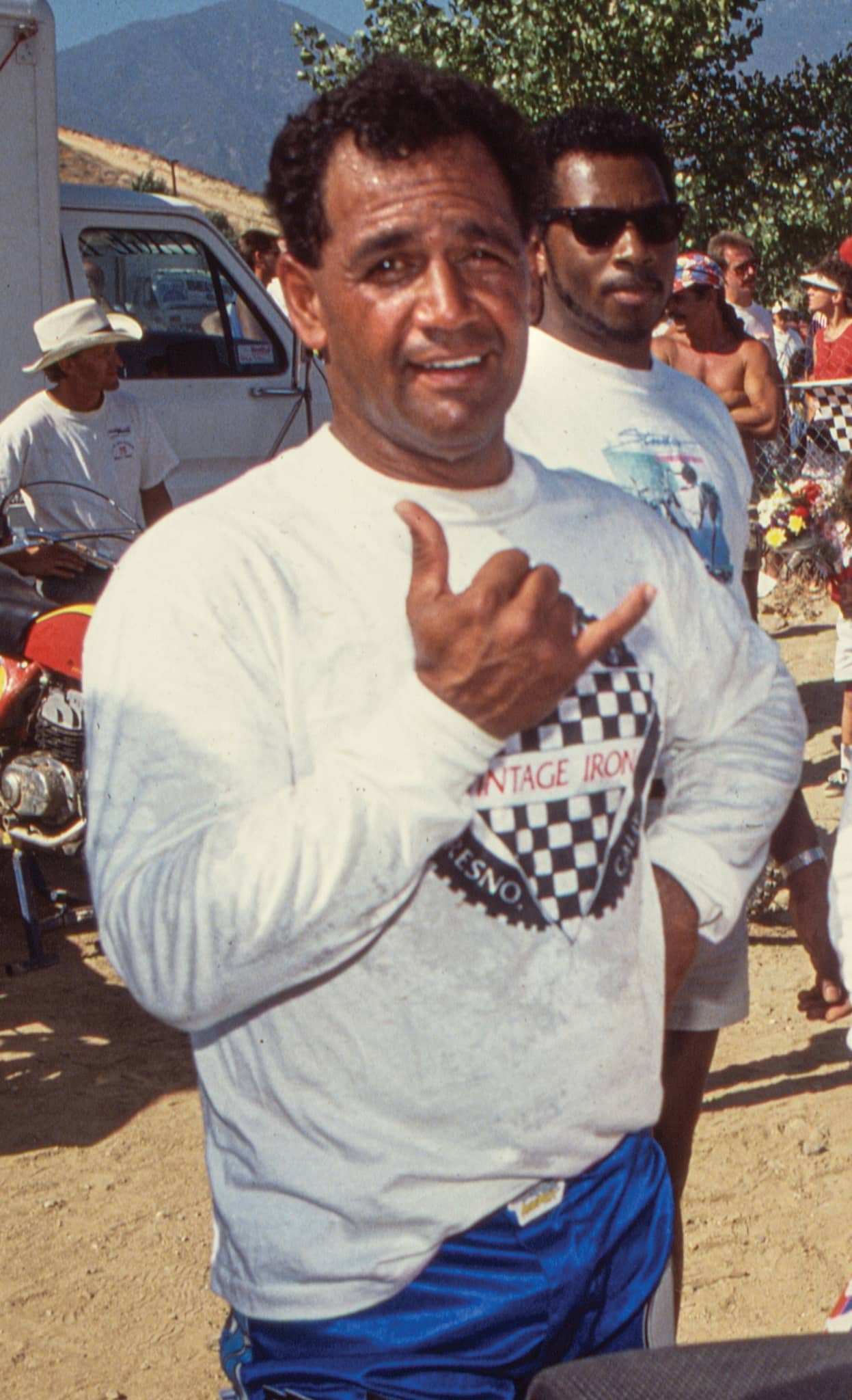 John at the long-forgotten 1999 World Vintage Championship race.
John at the long-forgotten 1999 World Vintage Championship race.
TELL US MORE ABOUT YOUR CZ YEARS? I felt really comfortable on the CZ. The CZ was built for me. I don’t think that I am Czechoslovakian at all, but I liked it. I loved every time we had “hand on the helmet” starts, because when they waved the flag, I never touched the clutch. I just put it in gear and went. That bike was so amazing and so unreal. Later at the L.A. Coliseum, I became the first rider to do the double jump. That is when the Japanese motorcycle industry came on board and wanted me to ride their bikes. I could not believe the amount of money that Kawasaki and Suzuki were willing to pay me to ride for them.
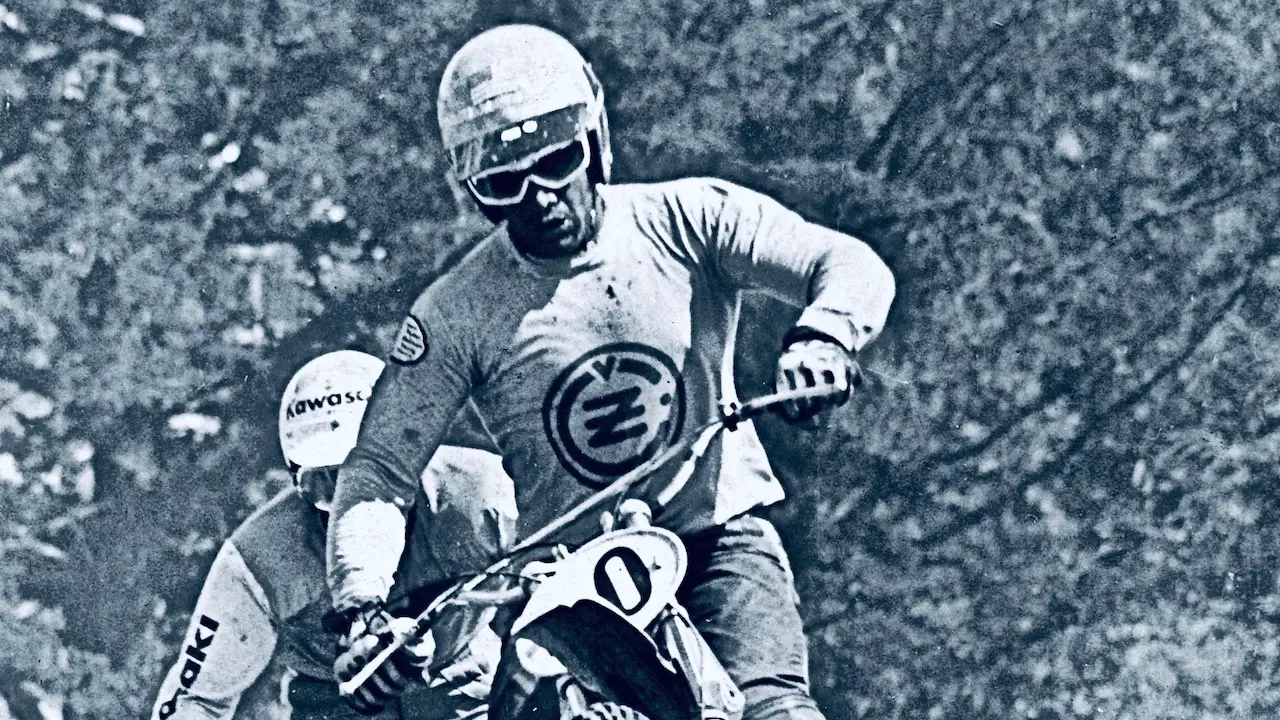
YOU GOT A KAWASAKI RIDE. HOW WAS THAT? When Kawasaki talked to me about the salary and payments that they would give me, I would always look at Pati, and if Pati said yes, I would tell them yes! They gave me a salary, a van and all that stuff. When Kawasaki decided to talk to Brad Lackey about riding for them, Brad would always tell them, “Whatever Pati says is okay, I will take it.” Pati was our negotiator. She was tough and very good at it.
HOW WAS THE BIKE? They would not take any advice. Whatever they planned to build, they built it. Brad and I told them that they should makes certain changes to the bike, and they would say, “No, this is how it is.” We were not the engineers or part of the production team making the bike. Finally, I thought to myself, “Okay, as long as we get paid.”
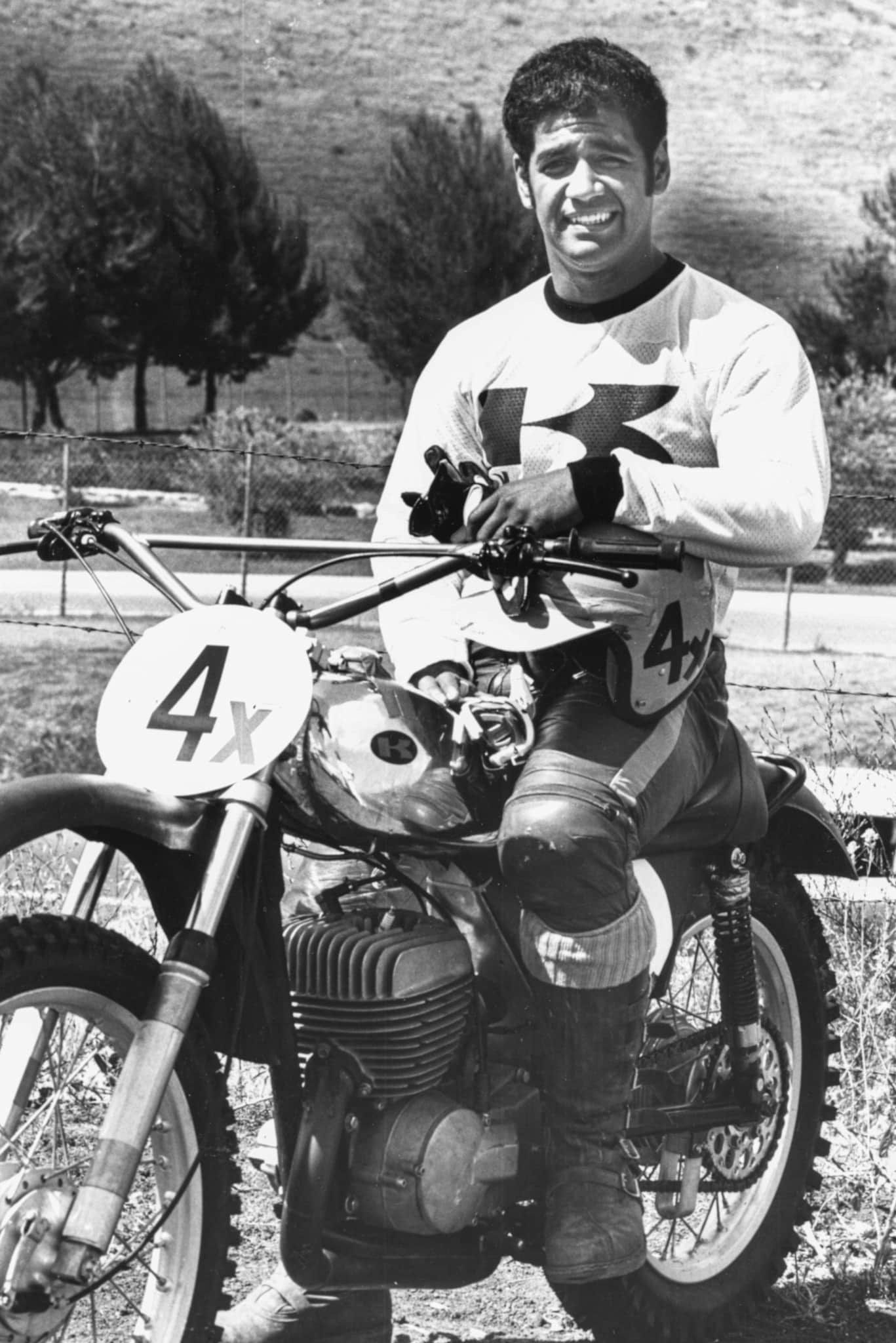 John and Brad Lackey raced for Kawasaki in 1973 and 1974.
John and Brad Lackey raced for Kawasaki in 1973 and 1974.
HOW DID YOU LIKE THE KAWASAKI COMPARED TO THE CZ? It was completely different, especially over the jumps. I could go faster on a lot more of the jumps because there was more suspension. The engines were very fast, but the power was not in the right place. The Kawasakis didn’t hold up very well back then, either. Something was always falling apart. I tried to give them advice on how to make it better. I thought they hired us to give them advice, but they only hired us for performance.
NEXT, YOU MOVED TO TEAM SUZUKI? Yes, and they gave me a lot more money. Suzuki was really a powerhouse back then. Technically, it was not that different from the Kawasaki. The big difference was in how much more money they paid me. Maybe we couldn’t influence the engineers that much, but it was awesome to get paid to ride and make a decent living. I was at Suzuki for two years—the same amount of time that I was with Kawasaki. I got enough money from Suzuki that my wife and I could buy a house in Huntington Beach. I loved it because it was close to the airport, which made it easier to fly to the next National and get home fast.
 John was one tough racer, but every rider eventually hits the dirt. Here, John is being helped from the track in 1973
John was one tough racer, but every rider eventually hits the dirt. Here, John is being helped from the track in 1973
HOW DID YOU MEET YOUR WIFE? My wife is from Hawaii, too. Back in the Montesa days, I was racing a Grand Prix in France and had a bad injury. I took a footpeg to the armpit. Back then, footpegs were just straight welded tubes. After getting hurt in France, I came home to Hawaii to heal. That is how I met my wife, Pati. We have been married 52 years.
Pati and I met in June when I initially got hurt, and when I healed up I told her, “I am going to go back to California to go racing.” She asked, “Can I come with you for two weeks?” She was an airline stewardess. I said, “Come on up, let’s go.” So, she came, and we stayed in San Diego because Edison Dye was sponsoring me on Husqvarna at the time. She was going to go back home in two weeks but ended up staying six months.
We both came home a couple of days before Christmas, and that is when my mom said, “Under the eyes of the Lord, you two are living in sin. You have been together for six months and you are not married. You guys should get married.” Suddenly, we found out we were getting married.
“MOTOCROSS IS GREAT. WE HAVE A LOT OF CLASSES AND A LOT OF YOUNG RIDERS. WE PROBABLY DON’T HAVE AS MANY RIDERS AS IN THE MAINLAND, BUT WE HAVE A LOT OF MINI BIKERS NOW. HAWAII IS DIFFERENT.”
WHEN DID YOU DECIDE TO RETIRE? It was in the late 1970s. We wanted to move back to Hawaii, so we came back home. I was in construction, and everything was good, and then suddenly people were asking me to run for the Honolulu City Council. I told them I had never voted in my life, and I didn’t know why I would want to run for elected office. But, they wanted me to be an example to the kids. I spent 16 years on the city council before retiring.
I still go to high schools and talk to the kids about growing up in Hawaii. My mom and dad hardly owned a house, and I was the oldest of six kids. But, I never let the negative part take control. That is how I became an all-star football player, undefeated in wrestling and the World Tandem Surfing Champion. When I came back to Hawaii, I saw all kinds of possibilities.
My wife loves horses, but I never rode a horse in my life, but I became the State Champion in Horse Reining and Cutting Horses. I kept doing all kinds of new and different things.
 Unfortunately, when John raced for Team Suzuki, he had to race a TM400.
Unfortunately, when John raced for Team Suzuki, he had to race a TM400.
HOW MANY INJURIES DID YOU HAVE FROM MOTOCROSS? I had a knee surgery, a broken back and a broken collarbone. I had 12 concussions, and that qualified me as “brain damaged.” I joke with people all the time that the brain damage “qualified me to run for politics” [laughs].
DO YOU STILL RIDE TODAY? Absolutely. I am the oldest one riding within my group of friends. I bought a Sherco a few months ago. My wife is so good about it and encourages me to ride, as she knows I love it.
HOW IS THE MOTOCROSS SCENE IN HAWAII? Motocross is great. We have a lot of classes and a lot of young riders. We probably don’t have as many riders as in the mainland, but we have a lot of mini bikers now. Hawaii is different. When I first started over here, we hardly had anybody. Racing was a combination of TTs and Scrambles. Nowadays I go ride at places that not too many people have the opportunity or privilege of seeing. When I am way up in the mountains, I can see the ocean from coastline to coastline. I am the only person that the military allows to ride up in the mountains. If they are going to build a road for the military in the mountains, they call me to check out the area first, because they know that there are archaeological sites up there. That is the stage that I am at right now. Of course, I like to go fast on the motocross track occasionally!
 That is “Super Hunky” (with the cigar), and John is sitting on the forward-falling starting gate at the 1973 Superbowl of Motocross.
That is “Super Hunky” (with the cigar), and John is sitting on the forward-falling starting gate at the 1973 Superbowl of Motocross.
JOHN, WHAT ARE YOUR FINAL THOUGHTS ON YOUR LIFE AND RACING? You must keep on going. That is what it is about. Just appreciate what you are doing and continue to do it. Don’t think of it as win or lose. You always win when you do what you love. It is a win/win situation. I appreciate you passing along my message of what the sport was before, what it is now and what it is going to take to continue to be what people want it to be.





Comments are closed.